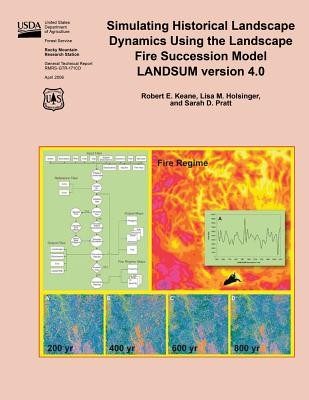
- We will send in 10–14 business days.
- Author: United States Department of Agriculture
- Publisher: CreateSpace Independent Publishing Platform
- Year: 2015
- Pages: 78
- ISBN-10: 1511608447
- ISBN-13: 9781511608442
- Format: 21.6 x 27.9 x 0.4 cm, softcover
- Language: English
- SAVE -10% with code: EXTRA
Simulating Historical Landscape Dynamics Using the Landscape Fire Succession Model LANDSUM version 4.0 (e-book) (used book) | bookbook.eu
Reviews
Description
The range and variation of historical landscape dynamics could provide a useful reference for designing fuel treatments on today's landscapes. Simulation modeling is a vehicle that can be used to estimate the range of conditions experienced on historical landscapes. A landscape fire succession model called LANDSUMv4 (LANDscape SUccession Model version 4.0) is presented here as a tool for estimating historical range and variation (HRV) of landscape characteristics. The model simulates fire and succession on fine scale landscapes for land management applications. It simulates vegetation development as a deterministic process by changing the species composition and stand structure assigned to a polygon. Disturbance initiation is modeled stochastically and disturbance effects are based on the current vegetation conditions of the polygon. Details of all model algorithms are discussed and the model is demonstrated for two applications. Results of an extensive sensitivity and model behavior analysis are also presented.
EXTRA 10 % discount with code: EXTRA
The promotion ends in 18d.20:13:01
The discount code is valid when purchasing from 10 €. Discounts do not stack.
- Author: United States Department of Agriculture
- Publisher: CreateSpace Independent Publishing Platform
- Year: 2015
- Pages: 78
- ISBN-10: 1511608447
- ISBN-13: 9781511608442
- Format: 21.6 x 27.9 x 0.4 cm, softcover
- Language: English English
The range and variation of historical landscape dynamics could provide a useful reference for designing fuel treatments on today's landscapes. Simulation modeling is a vehicle that can be used to estimate the range of conditions experienced on historical landscapes. A landscape fire succession model called LANDSUMv4 (LANDscape SUccession Model version 4.0) is presented here as a tool for estimating historical range and variation (HRV) of landscape characteristics. The model simulates fire and succession on fine scale landscapes for land management applications. It simulates vegetation development as a deterministic process by changing the species composition and stand structure assigned to a polygon. Disturbance initiation is modeled stochastically and disturbance effects are based on the current vegetation conditions of the polygon. Details of all model algorithms are discussed and the model is demonstrated for two applications. Results of an extensive sensitivity and model behavior analysis are also presented.


Reviews